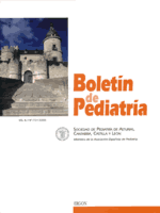Determinación de lactato en líquido cefalorraquídeo en niños con meningitis. Estudio de 124 casos
C.M. Navas Heredia , I. Sinovas González , F. Ballesteros Tejerino , F.L. Gallardo Hernández , L. Gómez López , J.M. Muro Tudelilla , E. Jiménez Mena
Bol. Pediatr. 2000; 40 (173): 160 - 165
Objetivo: Establecer la utilidad de la determinación de lactato en líquido cefalorraquídeo (LCR) para el diagnóstico precoz de las meningitis bacterianas. Métodos: Se estudiaron 154 muestras de LCR correspondientes a 124 niños con sospecha clínica de meningitis, cuyas edades oscilaron entre 1 mes y 9 años y 8 meses. Los pacientes se dividieron en 4 grupos: Controles (n=59), meningitis víricas (n=17), purulentas sin germen (n=29) y bacterianas (n=19). La determinación de lactato se realizó mediante método enzimático. Las cifras se expresaron en mmol/L. Resultados: Las cifras de lactato en LCR fueron: Controles (1,39±0,24), víricas (1,5±0,4), purulentas sin germen (1,93±0,41), bacterianas (7,54±4,2). Existieron diferencias muy significativas (p< 0,01. 10-3) entre meningitis víricas y bacterianas. No existió significación estadística entre víricas y purulentas sin germen. Se encontró correlación positiva entre la cifra de proteínas y lactato (R2 = 0,71; p<0,01). Estableciendo el punto de corte en unas cifras superiores a 2,7 mmol/L para la diferenciación entre meningitis vírica y bacteriana se obtuvo una sensibilidad del 84%, especificidad del 100% y valor predictivo positivo del 100%. Conclusiones: La determinación de lactato en LCR fue el dato analítico más fiable para el diagnóstico de meningitis bacteriana comparado con el resto de parámetros habituales (glucosa, proteínas, cloro, número de células). Proponemos por tanto la introducción del análisis de lactato de forma rutinaria en LCR en niños con sospecha de meningitis. Abstract Objective: To evaluate the diangostic use of cerebrospinal (CSF) lactate determination in the early detection of bacterial meningitis. Methods: A study was performed to analyse 154 CSF samples from 124 children with criteria for meningitis (range of age 1 month-9 years 8 months). The patients were divided into 4 groups: control group (n=59), viral meningitis (n=17), aseptic meningitis (n=29) and bacterial meningitis (n=19). Cerebrospinal fluid lactate was determined using an enzimatic method. The CSF lactate levels were measures in mmol/L. Results: The CSF lactate levels in the differente patient groups were: controls (1,39±0,24), viral meningitis (1,5±0,41), aseptic meningitis (1,93±0,41) and bacterial meningitis (7,54±4,2 ). There were found stadistically significant differences between the viral and bacterial meningitis groups (p< 0,01. 10-3) and no stadistically significant differences between the viral and aseptic meningitis groups. A positive correlation was identified between protein and lactate leveles (R2= 0,71; p< 0,01). The cut off for viral and bacterial meningitis differentiation was established by values ? 2,7 mmol/L with a sensitivity of 84%, specifitity of 100% and positive predictive value of 100%. Conclusions: The determination of lactate in CSF was the most accurate diagnostic test in bacterial meningitis in contrast to the rest of habitual methods like cell counts or glucose, protein and cloride determinations. We propose therefore the introduction of routine CSF lactate analyses in children with meningitis suspicion.
\N
\N
Artículo completo (PDF) (30 kb.)
- Urgencias/UCIP
